
Gaya is a city, municipal corporation and the administrative headquarters of Gaya district and Magadh division of the Indian state of Bihar. Gaya is 116 kilometres (72 mi) south of Patna and is the state's second-largest city, with a population of 470,839. The city is surrounded on three sides by small, rocky hills, with the Phalgu River on its eastern side.

Sita, also known as Siya, Janaki and Maithili, is a Hindu goddess and the female protagonist of the Hindu epic Ramayana. Sita is the consort of Rama, the avatar of god Vishnu, and is regarded as an avatar of goddess Lakshmi. She is the chief goddess of the Ramanandi Sampradaya and is the goddess of beauty and devotion. Sita's birthday is celebrated every year on the occasion of Sita Navami.
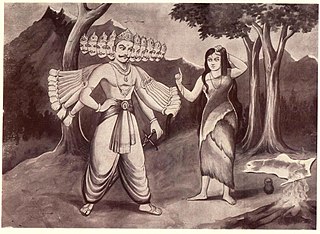
Vedavati is the previous birth of the goddess Sita in Hindu mythology. She is an avatar of the goddess of prosperity, Lakshmi.
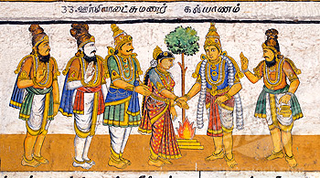
Urmila, is a Hindu goddess and the princess of Videha in the Hindu epic Ramayana. She is considered to be an avatāra of Nagalakshmi, the serpent goddess. Urmila was married to Lakshmana and is known for her dedication towards her husband, for her courage and sacrifice.

Anasuya is an ascetic, and the wife of Sage Atri in Hinduism. She is the daughter of Devahuti and the Prajapati Kardama in Hindu texts. In the Ramayana, she lives with her husband in a small hermitage on the southern border of the Chitrakuta forest. A pious woman who leads an austere life, she is described as having miraculous powers.

Gaya district is one of the thirty-eight districts of the Indian state of Bihar. It was officially established on 3 October 1865. The district has a common boundary with the state of Jharkhand to the south. Gaya city is both the district headquarters and the second-largest city in Bihar.

Janakpurdham or Janakpur, is a capital city of Madhesh Province. This sub-metropolitan city is a central hub for Maithili language, religious and cultural tourism in Nepal.

Yatra, in Indian-origin religions, Hinduism, Buddhism, Jainism and Sikhism, generally means a pilgrimage to holy places such as confluences of sacred rivers, sacred mountains, places associated with Hindu epics such as the Mahabharata and Ramayana, and other sacred pilgrimage sites. Visiting a sacred place is believed by the pilgrim to purify the self and bring one closer to the divine. The journey itself is as important as the destination, and the hardships of travel serve as an act of devotion in themselves.
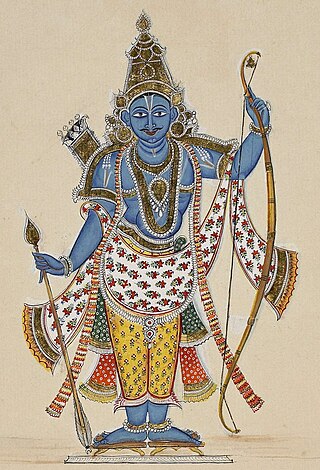
Rama is a major deity in Hinduism. He is worshipped as the seventh and one of the most popular avatars of Vishnu. In Rama-centric Hindu traditions, he is considered the Supreme Being. Also considered as the ideal man, Rama is the male protagonist of the Hindu epic Ramayana. His birth is celebrated every year on Rama Navami, which falls on the ninth day of the bright half of the lunar cycle of Chaitra (March–April), the first month in the Hindu calendar.
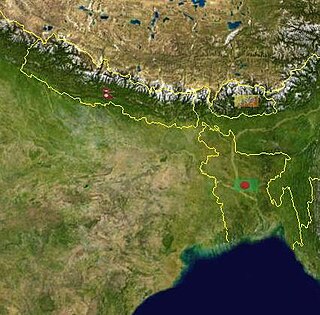
Bihar is located in the eastern region of India, between latitudes 24°20'10"N and 27°31'15"N and longitudes 83°19'50"E and 88°17'40"E. It is an entirely land–locked state, in a subtropical region of the temperate zone. Bihar lies between the humid West Bengal in the east and the sub humid Uttar Pradesh in the west, which provides it with a transitional position in respect of climate, economy and culture. It is bounded by Nepal in the north and by Jharkhand in the south. Bihar plain is divided into two unequal halves by the river Ganges which flows through the middle from west to east. Bihar's land has average elevation above sea level of 173 feet.
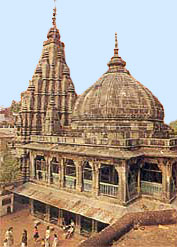
Vishnupad Temple is an ancient Hindu temple dedicated to Lord Vishnu in Gaya, Bihar, India, located on the banks of Phalgu river. The temple is believed to be built upon the site where Vishnu had purportedly killed the demon Gayasura or pinned him underground. The temple features a 40-cm footprint purported to be of Lord Vishnu incised into a block of basalt, known as Dharmasila which was retained when the deity stepped on Gayasura's chest before pinning him underground.

Paduka is an ancient form of footwear in India, consisting of a sole with a post and knob which is positioned between the big and second toe. It has been historically worn in South Asia and Southeast Asia. Paduka exist in a variety of forms and materials. They might be made in the shape of actual feet, or of fish, for example, and have been made of wood, ivory and silver. They may be elaborately decorated, such as when used as part of a bride's trousseau, but could also be given as religious offerings or themselves be the object of veneration.

The Sapta Puri are a group of seven Hindu tirtha, or holy pilgrimage sites, located in India. Pilgrimage to these sites is said to bless the pilgrim with moksha.
The Lilājan River is a river that flows through the Chatra and Gaya districts in the Indian states of Jharkhand and Bihar. It is also referred to as the Nilanjan, Niranjana or Falgu River.

The Punpun River is a tributary of the Ganges. It originates in Palamu district of Jharkhand and flows through Chatra, Gaya, Jehanabad and Patna districts of the Indian states of Jharkhand and Bihar. Punpun is a place named after the Punpun river in Patna which is situated on the bank of Punpun river. On the bank of Punpun people celebrate Chhath Puja.
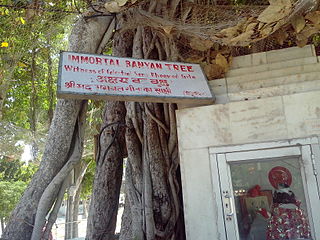
Akshayavata, also rendered Akshayavat, is a sacred fig tree mentioned in the Hindu religion. It is also the name of a sacred lake mentioned in the Puranas.
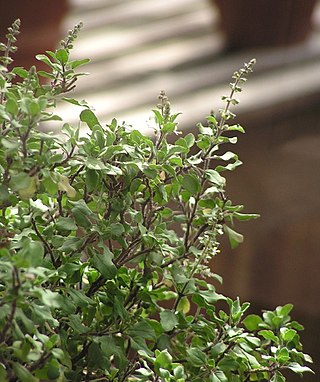
Tulasi, Tulsi or Vrinda is a sacred plant in Hindu tradition. Hindus regard it as an earthly manifestation of the goddess Tulasi; she is regarded as the avatar of Lakshmi, and thus the consort of the god Vishnu. In another iteration, as Vrinda, she is married to Jalandhara. The offering of its leaves is recommended in ritualistic worship of Vishnu and his avatars, like Krishna and Vithoba.
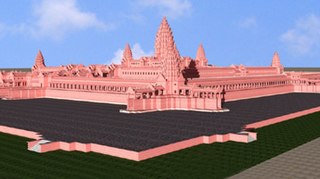
Viraat Ramayan Mandir is a under-construction Hindu temple complex located at twin villages of Kaithawalia and Bahuara near Chakia in East Champaran district, Bihar, India. It is being built with a cost of 5 billion rupees and is planned to be 123 metres (405 ft) high, double height of Angkor Wat Hindu Temple in Cambodia, and to have a hall that seats 20,000 people. The construction of the temple was scheduled to start in June 2015, but has been delayed following the Cambodia government's protest to the government of India which successfully won over Temple construction. Virat ramayan mandir's fully financed by mahavir mandir patna trust and client is tata company, company which given the civil work to suntech infra solutions. Company which is Delhi based company. Which work in previous in many Bihar project like in ntpc, fertilizer and iocl barauni projects successfully. This work is planning to finished in 2026.
Kauleshwari Temple is a pilgrimage centre where Kauleshwari Devi, a form of Sati/Kali, is worshipped. It is in the Chatra subdivision of Chatra district in Jharkhand, India.

Gayasura is an asura mentioned in Hindu texts like Bhagavata Purana and Vayu Purana who lived during the Treta Yuga. According to Hindu literature, he is regarded to have lived in the Magadha of present-day Bihar, India.



















